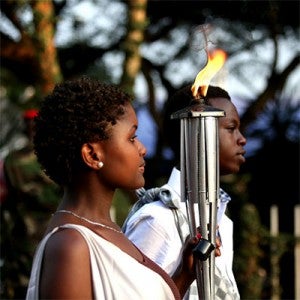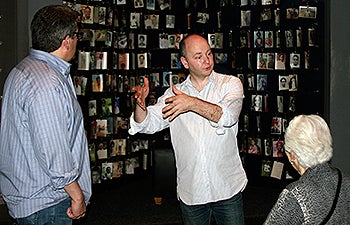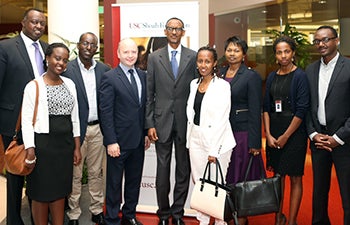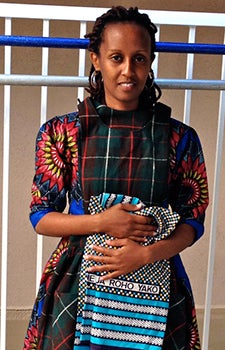Commemorating Genocide with Kwibuka20
Earlier this year, as Rwanda prepared to commemorate the 20th anniversary of the most painful period in its history, a single flame crisscrossed the central and east African sovereign state.
The flame symbolized remembrance, as well as the resilience and courage of Rwandans over the past two decades as they try to come to terms with the genocide in which Hutu extremists killed between 500,000 and one million ethnic Tutsis and moderate Hutus in approximately 100 days.
Carried in a simple lamp, Urumuri Rutazima — the eternal flame of memory — traveled to communities in Rwanda’s 30 districts, before arriving in the capital Kigali. There, on April 7, Rwandan President Paul Kagame used it to light the National Flame of Mourning. This marked the launch of Kwibuka20, the international commemoration of the 20th anniversary of the Rwandan genocide.

The Kwibuka flame, symbolizing remembrance, was carried through Rwanda’s 30 districts before reaching the capital Kigali where it was used to light the National Flame of Mourning at the April 7 ceremony commemorating the 20th anniversary of the genocide. Photo courtesy of the USC Shoah Foundation.
The official “Kwibuka” mourning — meaning “remember” in Kinyarwanda — began April 7 and ended July 4, Rwanda’s liberation day.
Stephen D. Smith, executive director of USC Shoah Foundation — The Institute for Visual History and Education, and adjunct professor of religion at USC Dornsife, was part of the team that came up with the commemoration. As executive producer of Kwibuka20, Smith, who was named UNESCO chair on genocide education last year, is responsible for running nearly 230 commemoration activities worldwide.
“As it’s the 20th year, we wanted to engage the whole Rwanda community, so we created an eternal flame of memory, which was carried like an Olympic torch throughout Rwanda so everyone could play a role in the commemoration and talk about their lives and their communities, how the genocide impacted them and how they have recovered,” Smith said.
For the past 13 years, Smith has been deeply involved with post-genocide reconstruction, reconciliation, education and commemoration. Before joining USC Dornsife in 2009, Smith worked in Rwanda for many years, co-founding The Aegis Trust, which helped establish the Kigali Genocide Memorial Centre in Rwanda in 2004.
As part of Kwibuka20, Smith helped create a series of “Global Conversations” focusing on prevention, in which world and community leaders came together to talk about the implications of genocide in terms of world politics. The series kicked off at the United Nations headquarters in New York on Jan. 15, 2014, followed by talks in Washington, D.C., London and Addis Ababa, Ethiopia.
In Rwanda, Smith worked on an international forum on genocide, hosted by the Rwandan Parliament from April 4 to 6. More than 200 delegates participated, including parliamentarians, policymakers, scholars and media personalities.

Stephen D. Smith, executive director of USC Shoah Foundation — The Institute for Visual History and Education, at the Kigali Genocide Memorial in Rwanda. Smith is the executive producer of Kwibuka20, the international commemoration of the 20th anniversary of the Rwandan genocide. Photo courtesy of USC Shoah Foundation.
“The legacy of the genocide in Rwanda created a struggle to restore human dignity at individual, community and national levels,” Smith said. “The conference offered an important opportunity to discuss enduring challenges of justice, education and reconstruction with experts from around the world. It was a chance to look at how Rwanda managed its re-emergence from genocide so we can learn from it and apply it to other societies in conflict today.”
On April 7, as many as 25,000 people, including Kagame and other world leaders, gathered at a Kigali stadium to hold a candlelit vigil and witness a dramatization of the genocide performed by 800 actors. The event was marked by displays of intense grief.
Nearly 10,000 miles away at USC, members of the Shoah Foundation Institute Student Association held their own vigil, reading survivor testimonies and distributing pictures of victims during the 100 days of terror.
“Our on-campus vigil was reflective of what was happening around the country,” Smith said. “It was good to see the USC student body taking the lead and showing how it’s done.”
Under Smith’s leadership at the institute, Rwandan genocide witness testimony is being integrated into USC Shoah Foundation’s Visual History Archive for use in research and education programs.
A recognized leader in the field of genocide education, Smith oversaw the 2012 launch of USC Shoah Foundation’s IWitness program, an award-winning, online resource providing secondary school teachers and their students throughout the world with more than 1,000 video testimonies of survivors and other eyewitnesses of the Holocaust to be used in classroom lessons. Rwandan genocide testimony and archives are also embedded into the program.

Rwandan President Paul Kagame (center) visits the USC Shoah Foundation in February 2014. Flanking him from left: Eugène Gasana, permanent representative to the U.N.; Aude Kamanzi and Medy Kimenyi of Aegis Trust; Stephen Smith, USC Shoah Foundation executive director; Edith Umugiraneza of the USC Shoah Foundation; Mathilde Mukantabana, ambassador of Rwanda to the U.S.; Consolée Uwamariya of the USC Shoah Foundation; and Paul Rukesha of Aegis Trust. Photo courtesy of the USC Shoah Foundation.
Kagame was so impressed with IWitness, he visited USC Shoah Foundation on Feb. 12, 2014 to learn more about the institute’s work linking testimony, technology and education.
For Smith, the most impressive aspect of IWitness has been seeing it in use in Rwandan classrooms.
He and his team visited a high school that is half a mile from a mass grave where 3,000 people were buried. In the school’s computer lab, they observed students working on a lesson about discrimination using Holocaust testimony from IWitness.
“By teaching about the Holocaust and doing it thematically, you raise the subject of genocide, but with safety and distance,” Smith said. “Rather than being a didactic lesson, students discover how the genocide happened through testimony on the website, then start to own the narrative.”
Among the Rwandan testimonies is that of Edith Umugiraneza, who lost her mother, brother and many other family members in the genocide.
“Surviving for me was a problem,” she said. “Because I was blaming, ‘Why did I survive, why I did not go with others?’ I had the question, ‘Why, why?’ all the time.”
Now living in the United States and an employee at USC Shoah Foundation, Umugiraneza found healing through prayer and by sharing stories with other survivors.

Edith Umugiranez, a Rwandan genocide survivor who now works for the foundation, in the dress she wore for three months during the genocide. “My mother gave me this African wrap because it was the rainy season at the time. She also gave me a necklace and said, ‘If they kill me, have this in remembrance of me.’ ” Photo courtesy of Edith Umugiranez.
“It happened and we can not bring back our people, so we have to move on and we have to help each other,” she said.
Along with Kings College, London, and the NIOD Institute for War, Holocaust and Genocide Studies in the Netherlands, USC is working with the Kigali Genocide Archive to build a digital system to preserve more than 60 million genocide documents and make them publicly available.
In 2011, Smith brought officials from the archive and education departments of the Kigali Center to USC for training. As a result, the Rwanda center has built new archival systems and education programs based on the institute’s work.
Smith is also working with the Rwanda Peace Education Program to teach tolerance using the methodology and archive of the USC Shoah Foundation and is helping the Rwandan government review its genocide education curriculum.
“Commemoration shouldn’t just be a reflection on the past, but should also involve rethinking of what those events mean in the present and within a learning environment,” Smith said. “Through research and teaching at USC we wanted to try connect that memorial moment with the value and benefits of research and education.”
Read about an upcoming book by Donald Miller of the USC Center for Religion and Civic Culture (CRCC) about the Rwandan genocide.